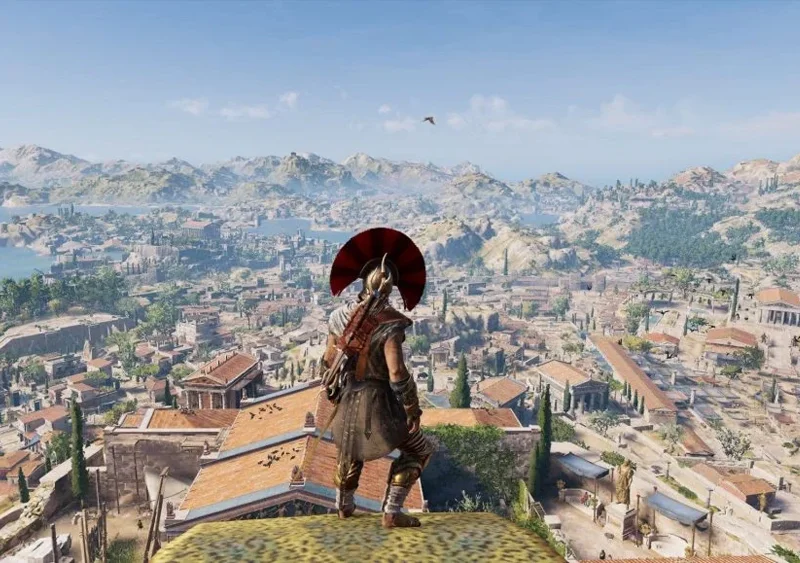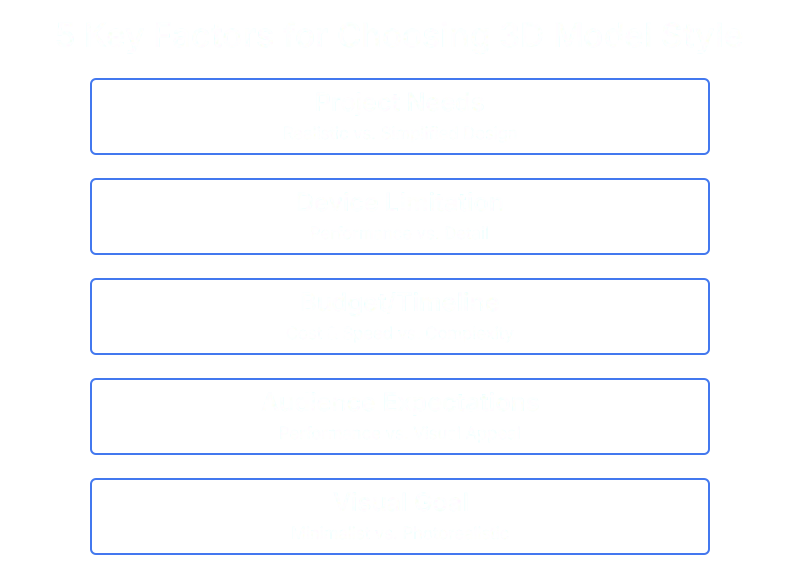Why Low Poly Modeling is Essential for Modern Game Design
Creating Visual Impact with Minimal Detail in Modern Games

6 MIN READ
December 13, 2024

Written By
Sasikumar Janakiraman
Low poly and high poly models cater to different needs, and understanding their strengths is vital to avoid costly mistakes. This blog walks through each approach to help professionals align their choices with specific project demands.
Low Poly 3D Models
Low poly 3D models are defined by their simplicity. These models use fewer polygons, making them lightweight and efficient. A polygon is the building block of 3D models, and fewer polygons mean reduced detail, but also faster performance. This characteristic makes low poly models ideal for applications where speed and efficiency matter most.
- Where Are Low Poly Models Used?
- Low poly models shine in industries where performance is non-negotiable. For example:
- Gaming: Low poly models are popular in mobile games and VR experiences, ensuring smooth performance on devices with limited processing power.
- AR Applications: Augmented reality platforms often require models that load quickly without overloading hardware.
- Prototyping: For quick visualizations, low poly models provide enough detail without consuming time or resources.
-
Why Choose Low Poly?
- Here’s why low poly models could be the right fit:
- Efficiency: With fewer polygons, these models render faster and are easier to handle in real-time applications.
- Cost-Effectiveness: Creating low poly models generally takes less time and effort, reducing production costs.
- Versatility: From mobile apps to online 3D experiences, these models adapt well to a range of platforms.
-
Limitations of Low Poly Models
- While low poly modeling offers many advantages, it’s not always the perfect solution. The simplicity that boosts performance can sometimes limit visual detail. For projects requiring intricate designs or high realism (such as architectural visualization or high-end product renders) this style might fall short.
High Poly 3D Models
High poly 3D models are known for their attention to detail and realism. These models use a large number of polygons to achieve intricate textures, smooth surfaces, and lifelike visuals. While they demand more resources, their ability to deliver stunning visual quality makes them a preferred choice in projects where detail matters most.
- 5 Factors Influencing the Choice of 3D Model Style
What Makes High Poly Models Different?
- At their core, high poly models prioritize quality over performance. Each polygon adds depth and detail, creating a model that feels rich and realistic. Unlike low poly models, which focus on efficiency, high poly models aim to replicate real-world textures and elements with precision.
-
Applications of High Poly Models
- High poly models are used in projects where aesthetics take precedence:
- Film and Animation: High poly models bring characters and scenes to life with precise detail, making them ideal for close-up shots.
- Product Design: For showcasing new products, high poly models help present every curve, texture, and feature in striking clarity.
- Architectural Visualization: High poly models allow architects to create immersive and realistic environments that clients can visualize in detail.
-
Benefits of High Poly Models
- Unmatched Detail: High poly models capture intricate elements, from subtle textures to complex structures.
- Realism: Perfect for projects requiring lifelike representations, such as high-quality renders or cinematic productions.
- Flexibility in Rendering: High poly models excel in non-real-time rendering, where performance is less of a constraint.
-
Drawbacks to Consider
- While high poly models deliver impressive visuals, they come with certain limitations:
- Performance Requirements: They demand significant processing power and memory, which can slow down workflows.
- Production Time: Creating high poly models takes more effort and time, increasing costs.
- Platform Restrictions: Not all devices or platforms can handle the complexity of high poly models efficiently.
Looking for 3D Product Modeling Services? Get top-quality models under $100 from a leading international 3D design studio!
5 Factors Influencing the Choice of 3D Model Style
Choosing the right 3D model style (low poly or high poly) depends on several critical factors. Each project has its unique demands, and understanding these factors ensures your choice aligns with your goals. Here's a breakdown of what to consider:

-
1. Project Requirements
- The nature of your project is the first consideration.
- Detail vs. Simplicity If your project requires realistic visuals, like product designs or architectural renders, high poly models are ideal. On the other hand, for mobile games or AR applications, low poly models balance detail with performance.
- Purpose Prototyping, animations, or real-time interactions often favor low poly due to speed, while pre-rendered visuals call for the detailed output of high poly models.
-
2. Platform Constraints
- Where your 3D models will be used determines their complexity.
- Hardware Limitations Devices like mobile phones or AR/VR headsets have limited processing power, making low poly models more suitable.
- Rendering Requirements High poly models can be rendered offline for videos or stills but may slow real-time interactions, especially in gaming or interactive experiences.
-
3. Budget and Timeline
- The resources available for your project heavily influence the modeling style.
- Production Costs High poly models take longer to create, requiring more expertise and resources, leading to higher costs. Low poly models are faster to produce, making them a cost-effective choice for projects with tighter budgets.
- Deadlines Tight deadlines often favor low poly models due to their quicker development time.
-
4. Target Audience and User Experience
- Understanding your audience helps you decide the right style.
- Interactive Applications For users engaging with your model on lower-end devices, prioritize performance and opt for low poly.
- Visual Appeal If your audience expects stunning visuals, such as in product marketing or entertainment, high poly models deliver the detail they need.
-
5. Desired Visual Outcome
- The final look you want to achieve plays a major role in your choice.
- Minimalistic Aesthetics Low poly works well for stylized, modern visuals.
- Realistic Renderings For photorealistic effects, high poly is the preferred option.
The Final Word
Low poly and high poly 3D models each serve unique purposes. Low poly is efficient and great for performance-focused projects, while high poly delivers unmatched detail for realistic visuals. The right choice depends on your project’s goals, platform, and resources. Align these factors, and you’ll ensure a smooth and successful outcome.
Collaborate with the Leading Global 3D Rendering Company for 3D Modeling Success.
About the writer :
Sasikumar Janakiraman, as the Creative Director at Zealous Services, brings a unique mix of creativity and technical ... skill. He’s passionate about 2D and 3D design, leading teams to create stunning 3D models and visualizations. Sasikumar loves working closely with clients, making sure their ideas come to life in the best possible way. His goal? To make design feel simple and exciting.
Read MoreFrequently Asked Questions (FAQ)
Can I combine low poly and high poly models in the same project?
Yes, combining low poly and high poly models in a single project is possible and sometimes beneficial. For example, in gaming, high poly models can be used for key assets or cutscenes, while low poly models handle background elements to balance performance and detail.
How do low poly and high poly models impact rendering time?
Low poly models generally render faster due to their simpler geometry, making them ideal for real-time applications. High poly models, however, require more rendering time and processing power, especially in non-real-time or cinematic projects.
Is low poly modeling easier to learn than high poly modeling?
Low poly modeling is often considered easier for beginners because it focuses on simplicity and basic shapes. High poly modeling involves advanced techniques like sculpting and texturing, requiring more skill and experience.
What file formats are best for low poly and high poly models?
For low poly models, formats like FBX and GLTF work well due to their compact size and compatibility with various platforms. High poly models often use formats like OBJ or STL to preserve intricate details in 3D printing or rendering.
Which industries rely most on low poly and high poly models?
Low Poly: Gaming, mobile applications, AR/VR, and real-time simulations. High Poly:Film and animation, product design, architectural visualization, and advertising.